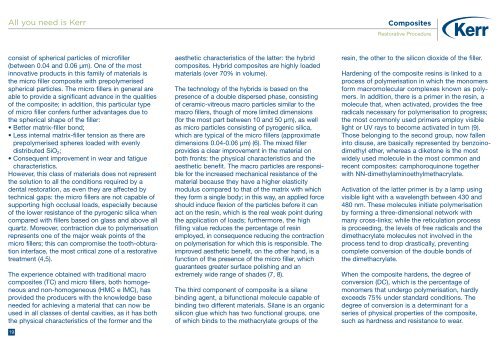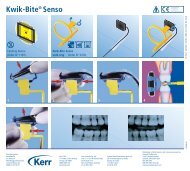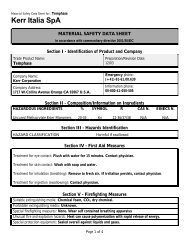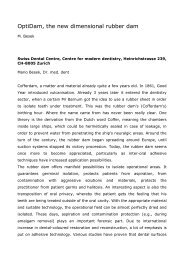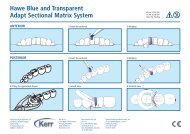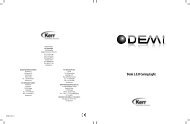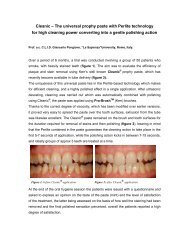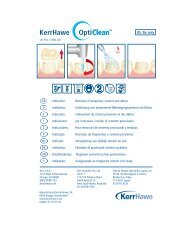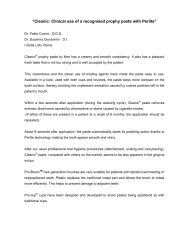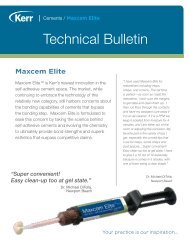Restorative Procedure - Kerr Hawe
Restorative Procedure - Kerr Hawe
Restorative Procedure - Kerr Hawe
You also want an ePaper? Increase the reach of your titles
YUMPU automatically turns print PDFs into web optimized ePapers that Google loves.
All you need is <strong>Kerr</strong><br />
Composites<br />
<strong>Restorative</strong> <strong>Procedure</strong><br />
consist of spherical particles of microfiller<br />
(between 0.04 and 0.06 µm). One of the most<br />
innovative products in this family of materials is<br />
the micro filler composite with prepolymerised<br />
spherical particles. The micro fillers in general are<br />
able to provide a significant advance in the qualities<br />
of the composite; in addition, this particular type<br />
of micro filler confers further advantages due to<br />
the spherical shape of the filler:<br />
• Better matrix-filler bond;<br />
• Less internal matrix-filler tension as there are<br />
prepolymerised spheres loaded with evenly<br />
distributed SiO 2 ;<br />
• Consequent improvement in wear and fatigue<br />
characteristics.<br />
However, this class of materials does not represent<br />
the solution to all the conditions required by a<br />
dental restoration, as even they are affected by<br />
technical gaps: the micro fillers are not capable of<br />
supporting high occlusal loads, especially because<br />
of the lower resistance of the pyrogenic silica when<br />
compared with fillers based on glass and above all<br />
quartz. Moreover, contraction due to polymerisation<br />
represents one of the major weak points of the<br />
micro fillers; this can compromise the tooth-obturation<br />
interface, the most critical zone of a restorative<br />
treatment (4,5).<br />
The experience obtained with traditional macro<br />
composites (TC) and micro fillers, both homogeneous<br />
and non-homogeneous (HMC e IMC), has<br />
provided the producers with the knowledge base<br />
needed for achieving a material that can now be<br />
used in all classes of dental cavities, as it has both<br />
the physical characteristics of the former and the<br />
19<br />
aesthetic characteristics of the latter: the hybrid<br />
composites. Hybrid composites are highly loaded<br />
materials (over 70% in volume).<br />
The technology of the hybrids is based on the<br />
presence of a double dispersed phase, consisting<br />
of ceramic-vitreous macro particles similar to the<br />
macro fillers, though of more limited dimensions<br />
(for the most part between 10 and 50 µm), as well<br />
as micro particles consisting of pyrogenic silica,<br />
which are typical of the micro fillers (approximate<br />
dimensions 0.04-0.06 µm) (6). The mixed filler<br />
provides a clear improvement in the material on<br />
both fronts: the physical characteristics and the<br />
aesthetic benefit. The macro particles are responsible<br />
for the increased mechanical resistance of the<br />
material because they have a higher elasticity<br />
modulus compared to that of the matrix with which<br />
they form a single body; in this way, an applied force<br />
should induce flexion of the particles before it can<br />
act on the resin, which is the real weak point during<br />
the application of loads; furthermore, the high<br />
filling value reduces the percentage of resin<br />
employed, in consequence reducing the contraction<br />
on polymerisation for which this is responsible. The<br />
improved aesthetic benefit, on the other hand, is a<br />
function of the presence of the micro filler, which<br />
guarantees greater surface polishing and an<br />
extremely wide range of shades (7, 8).<br />
The third component of composite is a silane<br />
binding agent, a bifunctional molecule capable of<br />
binding two different materials. Silane is an organic<br />
silicon glue which has two functional groups, one<br />
of which binds to the methacrylate groups of the<br />
resin, the other to the silicon dioxide of the filler.<br />
Hardening of the composite resins is linked to a<br />
process of polymerisation in which the monomers<br />
form macromolecular complexes known as polymers.<br />
In addition, there is a primer in the resin, a<br />
molecule that, when activated, provides the free<br />
radicals necessary for polymerisation to progress;<br />
the most commonly used primers employ visible<br />
light or UV rays to become activated in turn (9).<br />
Those belonging to the second group, now fallen<br />
into disuse, are basically represented by benzoinodimethyl<br />
ether, whereas a diketone is the most<br />
widely used molecule in the most common and<br />
recent composites: camphoroquinone together<br />
with NN-dimethylaminoethylmethacrylate.<br />
Activation of the latter primer is by a lamp using<br />
visible light with a wavelength between 430 and<br />
480 nm. These molecules initiate polymerisation<br />
by forming a three-dimensional network with<br />
many cross-links; while the reticulation process<br />
is proceeding, the levels of free radicals and the<br />
dimethacrylate molecules not involved in the<br />
process tend to drop drastically, preventing<br />
complete conversion of the double bonds of<br />
the dimethacrylate.<br />
When the composite hardens, the degree of<br />
conversion (DC), which is the percentage of<br />
monomers that undergo polymerisation, hardly<br />
exceeds 75% under standard conditions. The<br />
degree of conversion is a determinant for a<br />
series of physical properties of the composite,<br />
such as hardness and resistance to wear.


